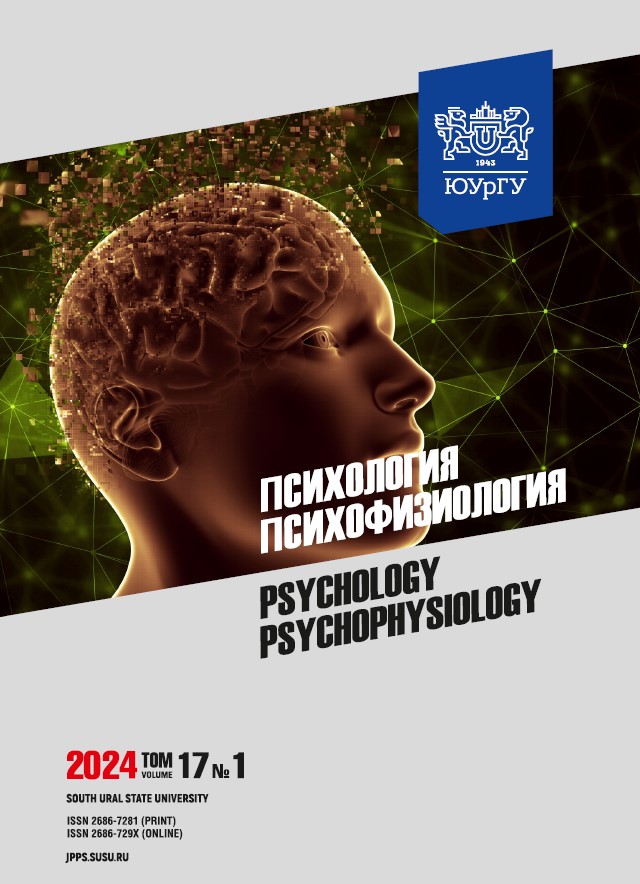Psychophysiological indicators in 11th grade students during the Unified State Exam
Abstract
Introduction. Although Russia has abandoned the Bologna education system, the Unified State Exam (USE) will not be abolished. Anzor Muzaev, the head of Rosobrnadzor, explains that the USE is based on Russian educational standards and provides an objective assessment of school graduates. Moreover, the USE fulfills the most important social tasks, including supporting the unified educational space of the Russian Federation. However, over the past 10 years, there has been an 11.3 % increase in the overall prevalence of mental disorders and behavioral disorders in adolescents aged 15-17 years, which is partly attributed to the highly stressful nature of the USE procedure. Aims. Тo conduct a longitudinal analysis of the dynamics of psychophysiological indicators in 11th grade students taking the USE in 2019, 2021, and 2023. Materials and methods. Psychological testing methods and computer chronoreflexometry techniques (SVMR-3) for the assessment of complex visual-motor reactions with a choice of two alternatives in three stages were employed. A total of 82 high school students participated in the study. Data analysis was performed using the “Statistical for Windows 6.0” software package. Results. A significant decrease in anxiety was observed in both boys and girls in 2021, after the cancellation of distance learning. The anxiety level decreased as students and teachers became familiar with and mastered the testing procedure for the USE and developed skills in control and self-organization, which would be maximally formed in 2023. Notable changes in dynamics were also observed in several indicators of a complex 3-stage visual-motor reaction (SVMR-3). The graduates of 2023 made the fewest differentiation errors. Lower indicators of SVMR-3 stable performance were recorded at the second stage, while higher ones were observed at the first and third stages. Conclusion. Timely assessment of the functional state of the central nervous system and related psychological indicators allows for the early identification of the features of the functional state of the central nervous system, the assessment of the risk of psychological changes, and correctional work.
Downloads
References
2. Gubareva L.I., Prasolova O.V. Functional state of the central nervous system in students of innovative schools. Fundamentalnye issledovaniya = Fundamental research. 2013;6(2):346–361. (in Russ.).
3. Gritsina O.P., Trankovskaya L.V., Semaniv E.V., Lisetskaya E.A. Factors shaping the health of modern children and adolescents. Tikhookeanskii meditsinskii zhurnal = Pacific Medical Journal. 2020;3:19–24. (in Russ.). DOI: 10.34215/1609‑1175‑2020‑3‑19‑24.
4. Lapteva E.A., Lyubovtsev V.B., Mamalyga L.M. Final certification in the SFC and USE format: psychophysiological characteristics of the condition of children in grades 9 and 11 under functional load caused by passing exam. Fundamentalnye issledovaniya = Fundamental research. 2013;7-3:575–579. (in Russ.).
5. Andreeva A.D. Methodology for diagnosing learning motivation and emotional attitude to learning in middle and high school. Psikhologicheskaya diagnostika = Psychological diagnostics. 2006;1:33–38. (in Russ.).
6. Spielberger C.D. Anxiety and behavior. New York: Academic Press. 1966:169
7. Chibisova M.Yu. Psikhologicheskaya podgotovka k EGE. Rabota s uchashchimisya, pedagogami, roditelyami [Psychological preparation for the Unified State Exam. Working with students, teachers, parents]. Moscow. Publ. Genesis. 2009:184. (in Russ.).
8. Lichko A.E. Psikhopatii i aktsentuatsii kharakterov u podrostkov [Psychopathy and accentuation of characters in adolescents]. Saint-Petersburg. Publ. Rech. 2010:256. (in Russ.).
9. Apchel V.Ya., Tsygan V.N. Stress i stressoustoichivost cheloveka [Stress and stress resistance]. Saint-Petersburg. 1999:86 (in Russ.).
10. Gubareva L.I., Konygeva Yu.G., Litvinova L.V. Features of the functioning of the central nervous system in boys and girls aged 16–17 years with different levels of anxiety and stress resistance. Vestnik psikhofiziologii = Bulletin of Psychophysiology. 2022;4:34–42. (in Russ.).
11. Gribanov A.V., Deputat I.S., Nekhoroshkova A.N. et al. Psychophysiological Characteristics of Anxiety and Intellectual Activity in Childhood (Review). Ekologiya cheloveka = Human Ecology. 2019;9:50–58. (in Russ.).
12. Enikeeva R.F., Kazantseva A.V., Davydova Yu.D., et al. The role of polymorphic variants of the contactin-associated-like protein-2 (CNTNAP2) gene in the formation of differences in anxiety levels. Nauchnye rezultaty biomeditsinskikh issledovanii = Scientific results of biomedical research. 2020;6(1):20–36. (in Russ.). DOI: 10.18413/2658-6533-2020-6-1-0-3
13. Alarcón M., Abrahams B.S., Stone J.L. Linkage, Association, and Gene-Expression Analyses Identify CNTNAP2 as an Autism-Susceptibility Gene. The American Journal of Human Genetics. 2008;82(1):150–159. DOI: 10.1016/j.ajhg.2007.09.005.
14. Peñagarikano O., Geschwind D.H. What does CNTNAP2 reveal about autism spectrum disorder? Trends in molecular medicine. 2012;18(3):156–163. DOI: 10.1016/j.molmed.2012.01.003.
15. Kazantseva A.V., Enikeeva R.F., Romanova A.R. et al. Genes of the neurexin family (CNTNAP2 and NRXN1): their role in the development of mathematical anxiety. Meditsinskaya genetika = Medical genetics. 2016;15(11):17–23. (in Russ.).
16. Malanchini M., Rimfeld K., Shakeshaft N.G. et al. The genetic and environmental aetiology of spatial, mathematics and general anxiety. Scientific Reports. 2017;7:42218. DOI: 10.1038/srep42218
17. Pavlov I.P. Dvadtsatiletnii opyt izucheniya vysshei nervnoi deyatelnosti (povedeniya zhivotnykh) [Twenty years of experience in studying higher nervous activity (animal behavior)]. Moscow. Publ. Nauka. 1973:661. (in Russ.).
18. Gubareva L.I., Konygeva Yu.G. Age dynamics of indicators of achievement motivation and emotional attitude to learning in middle and senior grades of school and its biological determinants. Vestnik psikhofiziologii = Bulletin of Psychophysiology. 2019;4:51–61. (in Russ.).
References on translit
-Copyright (c) 2024 Psychology. Psychophysiology

This work is licensed under a Creative Commons Attribution-NonCommercial-NoDerivatives 4.0 International License.



